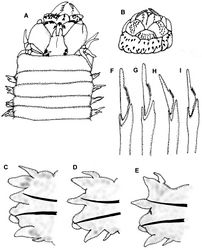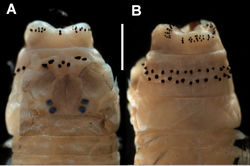Perinereis rookeri
| Notice: | This page is derived from the original publication listed below, whose author(s) should always be credited. Further contributors may edit and improve the content of this page and, consequently, need to be credited as well (see page history). Any assessment of factual correctness requires a careful review of the original article as well as of subsequent contributions.
If you are uncertain whether your planned contribution is correct or not, we suggest that you use the associated discussion page instead of editing the page directly. This page should be cited as follows (rationale):
Citation formats to copy and paste
BibTeX: @article{León-González2013ZooKeys312, RIS/ Endnote: TY - JOUR Wikipedia/ Citizendium: <ref name="León-González2013ZooKeys312">{{Citation See also the citation download page at the journal. |
Ordo: Polychaeta
Familia: Nereididae
Genus: Perinereis
Name
Perinereis rookeri León-González & Goethel, 2013 sp. n. – Wikispecies link – ZooBank link – Pensoft Profile
Type material
West coast of Florida, Naples, Rookery Bay, December 17-22, 2010 (holotype, UANL 7841), and 3 paratypes (HZM P-27422), FLW-Site3-Reef5-Rep2, 26°00.56'N, 81°44.90'W, 22/12/2010; One Paratype (LACM-AHF-4998), FLW-Site1-Reef2-Rep1, 26°01.55'N, 81°44.00'W, 17/12/2010; One Paratype (UANL 7842), FLW-Site3-Reef3-Rep2, 26°00.58'N, 81°44.24'W, 21/12/2010.
Additional material.
West Coast of Florida, Naples, Rookery Bay, December 17–21, 2010. One specimen (FSBC I 106475) from FLW-Site1-Reef3-Rep2, 26°01.54'N, 81°44.23'W, 17/12/2010; and one specimen from FLW-Site3-Reef3-Rep2, 26°00.58'N, 81°44.24'W, 21/12/2010.
Description
Holotype complete, 84 chaetigers, 52 mm in length, 2.5 mm wide at chaetiger 10 (excluding parapodia); 3.72 mm wide at chaetiger 10 (including parapodia). Paratypes complete with 75-87 chaetigers, 42-65 mm long, and 0.8–2.7 mm wide at chaetiger 10 (excluding parapodia).
Prostomium slightly wider than long, antennae minute, about ⅓ length of prostomium. Two pairs of eyes of similar size in trapezoidal arrangement. Biarticulate palps globose, with four pairs of tentacular cirri, posterodorsal pair extending back to posterior margin of first chaetiger (Fig. 1A).
Paragnaths black, cones on maxillary ring, cones and bars on oral ring, those of maxillary ring smaller. Area I = 2 cones in a line; Area II = 13 cones in 3 irregular rows; Area III = 18 cones in a quadrangular arrangement of 3 irregular rows, flanked by a left line of 3 cones and a right line of 5 cones; Area IV = 20 cones on the left, 17 cones on the right in a triangular patch, without bars; Area V = 3 cones in a triangle; Area VI = two short transverse bars; Area VII-VIII = 33 cones in two rows, basal row with slightly longer paragnaths in relation to those of the distal row (Fig. 1A–B, 2A–B).
First two parapodia uniramous, all others biramous. Parapodia of anterior region with short dorsal cirri, not longer than dorsal ligule, inserted basally, dorsal ligule subulate, notopodial ventral ligule subtriangular, without notopodial prechaetal lobe; neuropodia with superior lobe rounded, inferior lobe reduced, postchaetal lobe rounded, ventral ligule subulate, ventral cirri minute, inserted basally (Fig. 1C). Parapodia of median and posterior region similar in shape, notopodia with short dorsal cirri inserted medially, dorsal ligule subtriangular, notopodial ventral ligule subulate (Fig. 1D–E); neuropodial structures similar in shape along body.
Chaetation similar throughout body. Notochaetae all homogomph spinigers. Supracicular neurochaetae consisting of homogomph spinigers and heterogomph falcigers, the latter with straight blades denticulate on the basal half (Fig. 1F–G). Falciger blades of anterior and median parapodia longer than those of posterior ones. Infracicular neurochaetae consisting of heterogomph spinigers and heterogomph falcigers, the latter similar in shape and size gradation of dentition to supracicular ones (Fig. 1H–I). Anterior and median spinigers slightly longer than posterior ones.
Pygidium with terminal anus and a pair of short cirri (1.2 mm long) inserted ventrally to anal opening.
Remarks
Type and non-type specimens exhibit variation in paragnath counts for Area I, as follows. A single specimen with 1 paragnath, two specimens with 3 in a triangle, and the rest with 2 paragnaths in a line.
Discussion
Hutchings et al. (1991)[1] created an informal grouping of species belong to Perinereis based on the ornamentation of pharyngeal Area VI, and the development of the dorsal ligule. The species described here belongs to group 2A based on the presence of two short bars on Area VI and a dorsal ligule that is not greatly expanded. The following species belong to this group: Perinereis aibuhitensis (Grube, 1878) from the Philippines, Perinereis brevicirrata (Treadwell, 1920) from Southern Brazil, Perinereis camiguinoides (Augener, 1922) from Juan Fernandez Island, Perinereis jascooki Gibbs, 1972 from the Cook Islands, Perinereis kuwaitensis Mohammad, 1970 from Kuwait, Perinereis singaporiensis (Grube, 1878) from Singapore, and Perinereis vancaurica (Ehlers, 1868) from Nicobar Islands.
This group can be further subdivided by the presence or size of the notopodial prechaetal lobe. Perinereis aibuhitensis, Perinereis jascooki, Perinereis kuwaitensis, and Perinereis singaporiensis, possess only dorsal and median ligules, and the notopodial prechaetal lobe is reduced or absent. The absence of a notopodial prechaetal lobe places Perinereis rookeri sp. n. within this subgroup. Perinereis rookeri sp. n. and Perinereis singaporiensis are the most similar; both species have Area III with a rectangular group of small paragnaths arranged in 4 irregular rows, flanked by 8 cones in two vertical lines. The two species differ by the length of the tentacular cirri, the shape of the dorsal ligule, and the dentition on the inner margin of the falciger blades. The longest tentacular cirrus of Perinereis singaporiensis reaches chaetiger 4, while on Perinereis rookeri sp. n. it reaches chaetiger 1. The dorsal notopodial ligule on Perinereis singaporiensis is conical anteriorly and triangular on median and posterior notopodia, Perinereis rookeri sp. n. has subulate dorsal ligules on anterior notopodia and subtriangular on median and posterior notopodia. The falciger blades on Perinereis singaporiensis are subtriangular and denticulate on ¾ of their length, whereas those of Perinereis rookeri sp. n. are subulate and denticulate for only ½ of their length. The data listed here were taken based on Hutchings et al. (1991)[1], who reviewed the holotype of Perinereis singaporiensis. They note that this material is in very poor condition, however the pharyngeal arrangement, shape of the falcigers and number of chaetal lobes agree with their description. The original description from Grube (1878)[2] differs from the Australian specimens in that the longest tentacular cirrus extends to segment 5 and in the pharyngeal arrangement: Area I = 2 cones in line; Area III = 23 cones in transverse group with 2 cones on each side; Area V = 1 cone.
The range of Perinereis brevicirrata is the most geographically proximate to that of Perinereis rookeri sp. n., but the two can be readily distinguished morphologically. Perinereis brevicirrata has notopodial prechaetal lobes, Area V has 2 large cones, and Area VII-VIII has 3 lines of paragnaths. In Perinereis rookeri sp. n.notopodial prechaetal lobes are absent, Area V has 3 cones in a triangle, and Area VII-VIII has two well-defined lines of 33 paragnaths.
It is likely that Perinereis rookeri sp. n. specimens have been previously misidentified or grouped into a higher taxonomic group during previous benthic macroinvertebrate studies along the west coast of Florida.
Many studies throughout southwestern Florida collected only one species of Perinereis, Perinereis floridana, including a 1932 survey conducted around the Dry Tortugas (Monro 1933[3]) and a 1963 to 1969 Tampa Bay study, which included oyster reef sampling sites (Taylor 1971[4]). Many subsequent studies from southwestern Florida showed an absence of Perinereis species completely, including a 1957-1960 estuarine ecology study in north Florida Bay (Tabb and Manning 1961[5]). No Perinereis species were reported from within Rookery Bay during a 1984 to 1985 study; however, specimens labeled as Nereis or Neanthes sp. A were documented. The research also noted a lack of previous benthic macroinvertebrate research conducted specifically within Rookery Bay (Thoemke and Gyorkos 1988[6]). A 2006 study focused on epifaunal community development associated with artificial oyster reefs created near St. Petersburg also found no Perinereis specimens, although four unidentified Annelida species were reported (Dow 2008[7]). In northwestern Florida, during a systematic faunal inventory within Pensacola Bay from 1961-1963, three species of Perinereis were recorded, including Perinereis andersonni, Perinereis floridana, and an unidentified Perinereis species. All three species were considered rare, found only during the winter of 1962-1963 in areas with salinity at 20 ppt or greater and within a sandy-mud benthic habitat (Cooley 1978[8]). Taxonomic checklists for Florida list Perinereis andersonni and Perinereis floridana as the only two species of Perinereis found within Florida waters (Perkins and Savage 1975[9], Camp et al. 1998[10], Fauchald et al. 2009[11]).
Due to the probable association Perinereis rookeri sp. n. has with oyster reefs, it is likely that any occurrence in previous studies would have been rare. Perinereis rookeri sp. n. specimens, if previously collected, have presumably been misidentified or left at a higher taxonomic level in earlier research from Florida’s west coast.
Etymology
This specific name is derived from Rookery Bay National Estuarine Research Reserve on the west coast of Florida where the species was first discovered.
Distribution
This species is known from the Gulf of Mexico on the west coast of Florida, within Rookery Bay National Estuarine Research Reserve near Naples, where it was collected in association with oyster reefs in estuarine environments.
Ecological comments
Perinereis rookeri sp. n. was collected solely from oyster reefs within Rookery Bay National Estuarine Research Reserve. The oyster reefs located in Rookery Bay are shallow, intertidal reefs located in water depths of 1.2-1.5 m at high tide, with approximately 80% of the reefs exposed during low tide. Salinity at the sites where this species was found ranged from 35 to 37 ppt.
Original Description
- León-González, J; Goethel, C; 2013: A new species of Perinereis (Polychaeta, Nereididae) from Florida, USA, with a key to all Perinereis from the American continent ZooKeys, 312: 1-11. doi
Other References
- ↑ 1.0 1.1 Hutchings P, Reid A, Wilson R (1991) Perinereis (Polychaeta, Nereididae) from Australia, with redescriptions of six additional species. Records of the Australian Museum 43 (3): 241-274. doi: 10.3853/j.0067-1975.43.1991.47
- ↑ Grube A (1878) Annulata Semperiana. Beiträge zur kenntniss der anneliden fauna der Philippinen nach den von Herrn Prof. Semper mitgebrachten sammlungen. Memoires l’ Académie Imperiale des Sciences de St. Pétersbourg, série 7, 25(8): 1–300, 15 pls.
- ↑ Monro C (1933) On a collection of Polychaeta from Dry Tortugas, Florida. Annals and Magazine of Natural History, 10,12(69): 244–269. doi: 10.1080/00222933308655413
- ↑ Taylor J (1971) Polychaetous annelids and benthic environment in Tampa Bay, Florida. PhD thesis, Gainesville, University of Florida, Florida.
- ↑ Tabb D, Manning R (1961) A checklist of the flora and fauna of northern Florida Bay and adjacent brackish waters of the Florida mainland collected during the period July, 1957 through September, 1960. Bulletin of Marine Science of the Gulf and Caribbean 11 (4): 552–649.
- ↑ Thoemke K, Gyorkos K (1988) Distribution and abundance of benthic invertebrates in Rookery Bay National Estuarine Research Reserve: Final Report, Revised. Rookery Bay National Estuarine Research Reserve, 1–59.
- ↑ Dow I (2008) Epifaunal assemblage of a newly established oyster reef with two substrates. Master’s thesis, St. Petersburg, University of South Florida, Florida.
- ↑ Cooley N (1978) An inventory of the estuarine fauna in the vicinity of Pensacola, Florida. Florida Marine Research Publications 31: 1-119.
- ↑ Perkins T, Savage T (1975) A bibliography and checklist of polychaetous annelids of Florida, the Gulf of Mexico, and the Caribbean Region. Florida Marine Research Publications 14: 1-62.
- ↑ Camp D, Lyons W, Perkins T (1998) Checklists of selected shallow-water marine invertebrates of Florida. Florida Marine Research Institute Technical Reports TR- 3: 1-238.
- ↑ Fauchald K, Granados-Barba A, Solís-Weiss V (2009) Polychaeta (Annelida) of the Gulf of Mexico. In: Felder D Camp D (Eds). Gulf of Mexico–Origins, Waters, and Biota. Biodiversity. Texas A&M Press, College Station, Texas: 751-788.
Images
|

